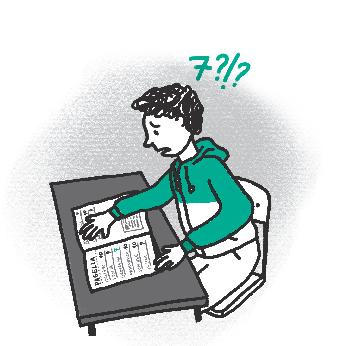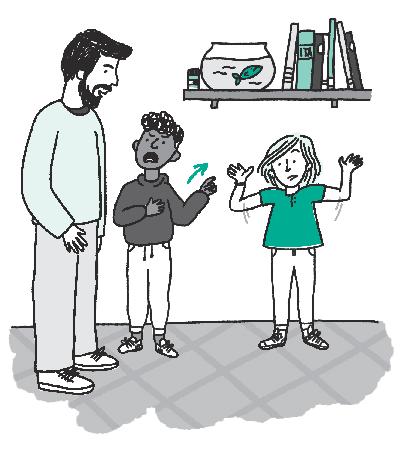EMOTIONAL DISORDERS
LOWER SECONDARY SCHOOL

WHAT TO DO
(and what to avoid)
QUICK guide for teachers



















(and what to avoid)
QUICK guide for teachers


















I am a psychotherapist with a cognitive-behavioural approach and, in addition to the clinic, I have been involved in training for primary and secondary school teachers on socio-affective education for the prevention of distress in the developmental age for more than ten years. I worked a lot with parent training with both children and adolescents who have had emotional disorders such as anxiety, depression and behavioural problems. In recent years I have mainly dealt with complex psychopathologies in adulthood. My greatest interest has always been aimed at the prevention and promotion of psychological health, which I consider an integral part of my profession, together with psychotherapy and in particular, primary prevention which includes interventions aimed at hindering and combating the onset of a psychological disorder. Working when a problem has been structured for some time is certainly more difficult. It’s not impossible, but it’s affected by many variables. For example, the age of the person, the maintenance period of the disorder and comorbidity with other disorders have a significant role in the prognosis. Although scientific research in the field of psychotherapy on emotional disorders is full of interventions with excellent efficacy results, there are problems that are difficult to treat, complicated personalities to work with, some to the point of not being suitable for psychotherapeutic work.
Every time I proceed with the psychological evaluation of a clinical case, I think about the signs that were not recognised, the resources present in the learning contexts (school and family),
the difficulties and traps that could have been avoided, had they been known, obviously.
Over the years, this has pushed me to become increasingly interested in primary prevention and to continue my work on the training of primary and secondary school teachers, places where children and young people can be better reached at the most sensitive age of their learning, and where interventions can therefore significantly impact their growth. School is considered the second educational agency par excellence after the family and, in some cases, it can become the only opportunity for the pupil to learn when the latter is unable to sufficiently fulfill its educational role. Since the 1990s, the World Health Organization has been promoting prevention interventions in schools such as socio-affective education and establishes that the best educational strategy is one aimed at strengthening personal skills through practical activities that help children and young people to develop them. Among these skills, empathy and the ability to manage one’s emotions play an important role in the person’s psychological wellbeing and constitute a protective factor against the development of psychological and behavioural problems. In the book you will find many practical tools for intervening in problem situations and just as many proposals for socio-affective education activities aimed at prevention, which I have developed over the years. All the proposed interventions will concern the educational relationship, in particular the student-teacher relationship and the relationship between classmates. I believe that both types of relationships are the places for excellence for learning at school. Without adequate care of a relationship, it is not possible to create skills, passion and the desire to become adults in children. Furthermore, attention to the relationship and the emotions that unfold within it can greatly facilitate the teacher’s task.
I hope that the book can represent a valid support for working with your students and, why not, that you can also find working on emotions useful in your daily life.

The objective of this book is to guide the teacher to recognize the signs of emotional distress in children in the developmental phase of pre-adolescence and provide clear and useful tools to intervene adequately within the margins of their own skills and responsibilities.
By signs of emotional distress, we mean those behaviours that may indicate transitory problems that children normally face in their developmental path, or that represent a risk for the development of real emotional disorders.
Without early and targeted intervention, some problematic behaviours at school can in fact, over time, worsen and become chronic, significantly compromising the student’s learning and general well-being.
On the contrary, good knowledge of emotional distress and intervention techniques that can be implemented in the school context can promote the development of socio-emotional skills in the student and have a positive impact on his growth path. In this regard, the World Health Organization¹ has been promoting socio-emotional education programs in schools for years aimed at strengthening socio-emotional skills through practical activities that help children develop them.
Socio-affective education is an educational approach aimed at developing and enhancing emotional intelligence in children and young people through specific practical activities to be used in the classroom. We can define emotional intelligence as the in-
dividual’s ability to manage and self-regulate from an emotional, cognitive and behavioural point of view in order to achieve their personal goals and establish healthy relationships with others. Through socio-affective education activities, the teacher works with his students on learning objectives, or on skills that are defined as socio-emotional skills:
1. self-awareness: evaluating one’s emotions, interests and values;
2. ability to manage oneself: regulate one’s moods to manage stress, control impulses, express emotions in the right way, become aware of one’s progressi;
3. social awareness: understanding others by appreciating others’ opinions, similarities and differences;
4. relational skills: building and maintaining positive and rewarding relationships based on cooperation, and asking for help in case of difficulty;
5. ability to make responsible decisions: respecting others, social norms, and taking into account the possible consequences of one’s actions.
Social-emotional skills are skills necessary to effectively face the inevitable challenges and difficulties that characterize the life of every human being.
For this reason they are also called Skills for life in the guidelines promoted by the World Health Organization on the promotion of health and the prevention of discomfort in schools.
The lack of social-emotional skills in a person can constitute a risk factor for emotional disorders in response to environmental stress.
Emotional disorders in developmental age refer to psychological and behavioural difficulties and are expressed by an inability to effectively manage one’s emotions in general or in relation to specific contexts. They are characterized by specific symptoms that can significantly invalidate the lives of children and young people, negatively interfering with their emotional and relational
growth. Emotional disorders can be divided into two categories in relation to the way in which emotional suffering is experienced by the person:
internalized disorders: these are disorders such as anxiety, depression, somatization. The discomfort is hidden and often difficult to identify because it is mostly experienced internally by the student. Furthermore, anxious or depressed children often do not create problems in class, therefore the discomfort is difficult to recognize and report by teachers; externalized disorders: the discomfort is poured outwards and manifests itself through problematic and disturbing behaviours such as hyperactivity, aggression, opposition or transgression. They are easy to identify because, unlike internalized disorders, pupils create evident discomfort in the environment and are thus reported more easily.
These two types of disorder can coexist in the same student: it is not uncommon for anxious students to demonstrate aggressive behaviour, for example. It must then be specified that not all problematic behaviours necessarily refer to emotional disorders. We speak of a disorder when harmful behaviour is frequent, intense, prolonged over time and creates significant discomfort for the person or other people.
However, identifying and intervening on certain behaviours early can impact whether or not a possible disorder develops.
In the book I will not directly address the various emotional disorders, but I will start from the observation of specific problem behaviours (which the teacher will be able to easily distinguish) to arrive at an understanding of the underlying emotions, the analysis of the dysfunctional dynamics and possible school interventions.
For each situation described, the emotional, cognitive and behavioural components will be taken into consideration as will
be seen within the various chapters. The link between thoughts, emotions and behaviours is the principle on which Rational Emotive Education (REE) is based,2 a psychoeducational approach for the developmental age linked to cognitive-behavioural psychotherapeutic intervention (Cognitive behaviour Therapy, CBT) and aimed at making children and adolescents acquire awareness of their emotions and underlying mental mechanisms. According to CBT, much of learning is mediated by cognitive processes (thoughts and interpretations of events) which, together with emotions and behaviours, influence each other (Di Pietro, 2013). International bodies such as the World Health Organization (WHO), the American Psychiatric Association (APA) and the Istituto Superiore di Sanità (ISS) recognize in their guidelines cognitive behavioural psychotherapy as particularly effective for the majority of emotional disorders. I believe it is important that teachers know that behind the proposed interventions there is a theory of the technique and scientific studies that demonstrate their effectiveness. The interventions are designed and constructed so that they can be easily applied by teachers while respecting their skills and possibilities. In addition to the proposed activities, worksheets and insights, greater emphasis will be given to communicative interventions that encourage emotional openness in students so that they can express their discomfort and learn to ask for help.
Currently, much emphasis is being placed on emotional regulation in the developmental age, considering the growing number of emotional disorders especially in the preadolescent and adolescent phases. In this period, children not only have little experience in managing relationships and the difficulties of their lives, but their brains are still maturing and therefore they present a normal evolutionary fragility in the regulation of their emotions. I am mainly referring to the response methods which in this phase
can be more impulsive (given by greater activation of the limbic system to emotional stimuli) to the detriment of modulated and more “thoughtful” responses due to the immaturity of the prefrontal cortex. In the pre-adolescence phase (11-15 years) cognitive abilities pass from the phase of concrete operations, typical of children, to that of formal operations. Thinking becomes more abstract and children begin to develop the ability to deduce and hypothesize. In adolescence (16-19 years) this process continues and tends to stabilize. It is also the period of major physical and hormonal changes and children are able to make complex reasoning, they are more interested in love relationships and sexuality, they question themselves on existential matters. The cognitive processes involved in the ability to regulate one’s emotions, such as inhibitory control, abstract thinking and the ability to weigh the consequences of one’s actions, are evolving and continue to mature throughout adolescence. This process is strongly influenced by environmental factors and psychological variables within educational contexts where children experience challenges, disappointments and achievements. The school’s response to this need translates into supporting children, through socio-emotional education programmes, so that they can be guided and stimulated in learning emotional regulation skills in this delicate phase of their growth.
Furthermore, working in this direction also has a positive impact on the climate and learning at school. The close relationship between emotions and learning processes is now known (Ianes and Cramerotti, 2020): children who experience positive emotions and relationships with peers and teachers will be more likely to have a good self-image (self-esteem), to feel capable (self-efficacy) and motivated to learn. Experiencing emotional problems in the developmental age, such as anxiety and depression or anger, seizes strength and energy that should be directed towards growth, exploration and knowledge. This is not to say that kids shouldn’t also have to go through unpleasant emotions, far from it. But it’s one thing to go through difficult times, it’s another to
develop an emotional disorder where psychological stress can invalidate the child’s social and academic functioning.
As already mentioned, in the practical indications I have favoured the in-depth study and training of empathic communication: emotional mirroring. Before understanding in detail what it is, it will be useful to make a premise on the concept of empathy.
Empathy is the ability to deeply understand another person’s moods, to feel what the other feels and put yourself in their shoes. This experience is momentary: if this were not the case and we were overwhelmed by the emotions of the other, we would find ourselves faced with an emotional contagion, different from empathy. Let’s imagine we start crying non-stop with our friend who tells us an important problem. Let’s imagine instead of being moved with him, remaining steadfast and present for him. In the first case we talk about emotional contagion, while in the second we talk about empathy.
Empathy is expressed through various verbal and non-verbal behaviours. We can be empathetic even if we don’t show it to the person in front of us. Let’s think about watching a dramatic film: we can empathize and feel the emotions of the actors without them knowing it.
Emotional Mirroring, on the other hand, is an action that demonstrates to the other person that we understand them deeply and also has a function of containing moods. By containment we mean the ability to be of help to the person who is showing us an emotion, without offering solutions. It means being there for the other, listening to them and believing in the emotions they feel. When we feel understood by others we experience different help. There is no advice or solutions for the problem we are having, but we feel that we are not alone: this is the function of containment. Mirroring is therefore expressed through gestures, facial expressions, proxemics (a hug, a caress, a kiss, an expression con-
sistent with the emotional context) and above all with empathic comments (“I imagine you feel hurt”, “I can imagine that you are sad”, “of course I understand how angry this can make you”, “I see you’re happy”, etc.) designed to confirm the state of mind that the other is bringing us. Mirroring a person’s emotional state does not mean giving advice, nor looking for solutions or making light of things. In mirroring, we act as a mirror to the emotions of the other, that is, we confirm the emotion that the other is bringing to us, we believe what the other feels. This mode of communication is therefore very linked to empathy. There is no emotional mirroring without empathy, but there can be empathy without emotional mirroring, so we can feel and understand the other’s emotion and not have the ability to enter into deep contact through gestures and words that demonstrate it. Is it necessary to demonstrate to the other that we have empathized with him and therefore understood him? In the interpersonal relationships that characterize everyday life we can choose to do so or not. What is certain is that if we tune into a person’s needs and demonstrate it to them, we will be more likely to build a deep relationship with them. If we move to the school environment, this choice becomes decisive for the teacher’s work. Knowing how to reflect the emotional state of a student has great educational value, as it allows us to give meaning to their emotional experiences which are still in the process of evolving. Adults in general are regulators of meaning for children and teenagers: for this reason the words, gestures and behaviours that are implemented towards a student constitute a learning model for him.
Mirroring emotions helps the student to: validate his emotional experience, which translates into the sentence: “What I feel is true, the adult understands it, therefore there is a reason why I feel this emotion” (recognizing emotions);
understand that emotions can be expressed, which translates into the sentence: “The teacher understood how I felt, I didn’t
feel judged, next time I know I have a space where I am listened to and understood” (containment of emotions); manage your emotions. If the emotional experience is validated, if the student has the space and the possibility to express what he feels, he will compare himself more often with the adult and will train to stay in touch with his emotions, a necessary condition for learning to tolerate them, he will experience that it is sustainable and that he can do it (self-regulation).
Working in the classroom with Emotional Mirroring will give your students the opportunity to experience the understanding and closeness of adults, learn to express themselves adequately, better understand their own emotions and those of others, and establish meaningful relationships.
It is good to remember that the indications in this volume have the aim of helping the teacher to orient himself in difficult situations and not to solve all the problems of his students.
The teacher must keep in mind the limits of his role both because, if he were to go beyond it, he would risk feeling impotence and frustration, and to avoid an overload of responsibilities beyond the teaching ones. In my online and in-person training experience I have worked mainly with teachers who are very interested in specializing in the emotional education of their students. Those who are interested in these topics are often passionate about their work as educators and have a personal sensitivity and tendency to help others. While on the one hand this may represent the optimal condition for training in emotional education, on the other hand you run the risk of going beyond your skills and becoming entangled in situations where it is not possible to intervene. In some cases it can even be counterproductive for students. The teacher who is aware of his own intervention limits is an adult who shows confidence in
giving when he can and asking when needed. It is also easier for pupils to deal with problems if they move within clear boundaries that only adults - in this case teachers - can provide.
However, it is possible that the teacher finds himself having to manage emergency situations. Imagine, for example, a student who experiences a panic attack at school. The teacher’s intervention in the emergency is aimed at welcoming and containing the student’s emotional experience at the moment, but will have to consider the involvement of a psychologist if the episodes become frequent. In this case we could find ourselves faced with a structured anxiety disorder that requires in-depth evaluation and intervention by a psychotherapist.
The emotional dimension is a strictly relational phenomenon, therefore the ability to self-regulate is learned within the relationship with others. Every human being learns to express their discomfort, more or less effectively, depending on the quality of the relationships they have experienced in their evolutionary path. Our focus will therefore be the teacher’s response to the more or less explicit requests for help from his students.
The book is divided into 3 sections and 15 chapters, each of which examines problematic behaviour that the teacher may have to face in the classroom and which may be an indication of the pupil’s emotional difficulties.
The behaviours described have been grouped and divided into 3 sections, depending on the emotions examined. We will therefore find five chapters/behaviours for each section:
section 1: fear and anxiety
section 2: rage and anger
section 3: sadness and depression.
Grouping behaviours and dividing them by specific emotions is not a simple operation because it does not represent an exhaustive classification. Many behaviours, in fact, are linked to more than one emotion; furthermore, experiencing specific emotions does not necessarily produce certain behaviours. However, scientific literature and clinical experience help us to understand how some behaviours are often indicative of specific discomforts in the developmental age, which should then be examined in depth on a case-by-case basis.
The title of each section includes an emotion and its maximum intensity level (for example, fear and anxiety). The choice refers to the desire to immediately introduce teachers to the concept of emotional self-regulation understood as the individual’s ability to consciously and adaptively manage emotions, thoughts and behaviours. For example, the emotion underlying anxiety is often intense and difficult to manage fear. Sadness, if prolonged over time, can lead to closure and depression. Even anger, if intense and unregulated, would become anger which can generate into aggressive behaviour. Pupils who have difficulty managing their emotions may present specific behavioural problems: if appropriately identified, these can however be overcome and considered as normal difficulties in the developmental process.
Each chapter includes a brief overview of a specific behaviour (what to keep in mind), indications on the intervention (how to intervene), suggestions and insights (expert advice and in-depth analysis). The teacher will be guided to understand the situations described through emotional, cognitive and behavioural reading.
The tools presented refer to short- and long-term interventions. This approach has a dual objective and responds to two needs of both the teacher and the student:
the teacher’s need to know what to do and what to say (and what not to do and what not to say) when a certain behaviour occurs and to how intervene effectively (short term); to the student’s need to develop the skills necessary to face the difficulties and challenges that life will present to him (long term).
For short-term interventions, particular emphasis was given to emotional mirroring, a mode of empathic communication which serves, in short, to tune into the pupil’s emotions and foster the relationship with him.
Regarding long-term interventions, group activities were favored to enhance pupils’ social-emotional skills (Social-Affective Education activities). The objective is also to create learning opportunities for the entire class group and encourage inclusion.
Remember: every time a problem emerges, the teacher has the precious opportunity to teach their students how to tackle it together,strengthen their social skills and provide a cooperative model.
I hope that this book can offer valid support in educational practice and an incentive to look at the student (and why not, also at others in general) beyond his problem behaviour.
Happy reading and good work!



Because he thinks that his school grades give value to him as a person.
Because he believes that getting a good grade will make him more loved by his parents.
Because he believes he is only valid in the school context.
Because he feels burdened by the expectations of his parents and/or teachers.





Say openly that the grade is not a judgment of himself as a person
Reward his qualities outside of the assessments of school work
When faced with an error, it is better to say “I see you had difficulty here”
Normalise the mistake by saying “It can happen, I used to get low grades too, you know?”


DO NOT wait for a good grade to congratulate your student, recognize their daily effort
DO NOT say “You made a mistake here” or “You don’t understand”
DO NOT use labels such as lazy, slow, exaggerated, precise, obsessed, nerd

Other specific characteristics are often observed in children who are excessively worried about grades: they are precise and diligent, they are afraid of making mistakes and they are hypersensitive to criticism. It is possible that these children may develop performance anxiety in the future accompanied by the false belief that they are lovable based on their performance. It is understandable and desirable for parents and teachers that children and pupils are obedient and good at school, but we must be careful that this does not become a rigid way of representing themselves. Together with the evaluation of academic achievement and behaviour, the school’s task is also to teach students how to face fears and difficulties and facilitate the way in which these moments will be experienced in the future. Thanks to the studies of Daniel Goleman and WHO research in the educational field, it has been proven that to be successful in life it is necessary to acquire social and emotional skills and that these skills can also be taught in the school context. Learning outside and inside school is characterized by errors and failures. The phrase “You learn from your mistakes”, however rhetorical, realistically defines every educational path: it would be irrational to imagine such a path without errors or unexpected events. A student who is excessively worried about his academic performance, therefore, pursues an illusory goal that will inevitably lead him to clash with his natural fallibility. The risk is that
they may start to build their self-esteem on the basis of the grades obtained at school, triggering a negative vicious circle.
Children need to know that they have value regardless of their academic success: we must convey this awareness through behaviour, not just words.
It is useless to explain that grades are not important if we are the first to evaluate them from one to ten or if in reality we are only attentive to academic performance.
Having a calm and non-judgmental attitude when faced with failure can be helpful.
Considering the error as a foreseeable possibility in a task or a question can help the student to accept it as a natural part of his learning process and to not experience states of high stress.
Keep in mind that the fear of making a mistake or getting a bad grade is experienced before or during a test, therefore performance anxiety could significantly affect the result even if the student is prepared. For this reason, a calm and welcoming behaviour on the part of the teacher can positively influence the attitude towards the task.
When a student is excessively worried about school grades, he will most likely talk about homework and tests frequently and appear to have no other interest than grades,


including those of his classmates. His thoughts are polarized on his performance and perhaps he will neglect other aspects of school life such as relationships with peers.
You can shift his attention to other activities or details of a task through what is called cognitive distraction. Reward him by, for example, grasping skills that are not attributable to performance but to his personal characteristics (intuition, preferences, emotions).
You can involve the whole class in socio-emotional education activities. It can be an excellent way to make students understand that our interest is also oriented towards their empathic skills, their creativity, and their way of relating to their classmates.
Don’t minimize his concerns, show understanding and help him express his emotions.
Share with him an event from your past in which you experienced the same state of mind that you then overcame. This way you will convey that he too can manage to deal with the same situation.
Avoid immediately pointing out a mistake and try to understand with him the difficulties he encountered during the task.
If he gets a low grade, along with his grade, write specific and descriptive feedback about a part of the assignment that was correct.
Rewards the student for his personal qualities such as curiosity, courage, solidarity, sense of humor, empathy. It will help him shift his attention from performance to other important aspects of himself.




Because he is used to getting help and does not recognise his responsibilities.
Because he fears failure and judges himself globally in relation to it.
Because he is afraid of being punished.




Keep facts and emotions separate
Reflect your student’s emotions: they are true even if linked to a misinterpreted fact
Offer your help to understand together how to recover from the mistake, regardless of the reasons for it


DO NOT belittle his emotions
DO NOT focus on his excuses and try to reason with him in that moment
DO NOT judge him as irresponsible

During the developmental age, your students are learning to represent themselves and understand the causes of what happens around them. This process is very important in order to orient their behaviour in an adaptive way. Each of them will develop their own attributional style, also called locus of control, or a way through which to attribute causes to events, whether within or outside of their control. In the case of internal locus of control, the student represents himself as responsible for his own actions, he knows he can intervene on them to achieve a goal and this awareness increases his self-esteem.
In the external locus of control, the student tends to trace the causes to external factors and therefore not directly manageable: even if he may feel relieved of responsibility by the error, in fact he is not driven to improve himself but to avoid potentially unsuccessful situations with negative consequences on the perception of oneself and its effectiveness.
If no action is taken on the de-responsibility scheme, anger towards others could persist and intensify over time, creating significant discomfort in social relationships.
Intervening on the attributional styles of your students means teaching them to distinguish adaptive styles from maladaptive ones, that is, those that allow us to face problems and improve ourselves from those that create in us a sense of inadequacy and impossibility of change.
Just as the attributional style can be learned, it can also be modified through specific intervention programmes that positi-
vely restructure any inadequate style or support and reinforce the adequate one.
To have an active role in their school career, the student must be aware of what he does and why he does it. For this reason, interventions aimed at strengthening meta-cognitive skills understood as the ability to reflect on one’s own thought processes can be useful.
Make complex activities simpler by dividing them into simpler sub-objectives and ask your students which of them they would like to achieve. In addition to making their work easier, you will help them take on an active role in learning.
Have your students talk about their past experiences in which they achieved a learning goal and the emotions they felt. Next, ask them about the academic and non-scholastic goals they would like to reach in the future, and discuss with them the attitudes they can adopt to reach them.
Use positive communication with your students. If successful, it reinforces personal characteristics and underlines that the result was achieved thanks to controllable factors such as commitment and the use of effective strategies. In case of failure, give feedback only on performance and point out that it is the result of insufficient effort and failure to use appropriate strategies.

Setbacks and failures are a natural part of the learning process: only by internalizing this concept will you be more likely to convey the same message to your students.
Offer opportunities for recovery and give positive feedback even for small results: this will help the most vulnerable students accept their mistakes more willingly without becoming demoralized.
If one of your students blames others or situations for his mistakes, don’t contradict him, for example saying “The responsibility is yours alone!” or “Don’t make excuses!”, move on and focus on the task and what you can do next time to achieve the goal: “So, let’s see how we can make sure that you have the optimal conditions to succeed in the task.”.
Don’t forget that you have an attribution style too!
Observe yourself and be aware of how to improve yourself.



We have seen that knowing attributional styles can be useful in orienting one’s behavior towards study and problems in an effective and adaptive way. The figure below is a preview of the “Attribution Questionnaire”, downloadable from the online resources, which will allow you to evaluate your students’ motivation for a specific discipline. Discuss the results obtained together with your students. It will help them to be aware of their own attributional style and will serve to improve the motivational aspects linked to learning.







Because he has had negative experiences with peers and is afraid that they may happen again.
Because he has low self-esteem and overestimates others, by whom he thinks he will be judged negatively.
Because he feels apathetic. His mind and energy are hijacked by issues outside of school and he is unable to find pleasure in interactions.

Talk to your student and communicate your understanding through emotional mirroring.
Talk to parents to understand the family situation and inform them of the discomfort in class.
Organise social-emotional education activities with the class in circle time.


DO NOT talk about his school performance and focus on the emotions he expresses
DO NOT use phrases like: “Why are you always alone?”, “You have to be with your classmates too!”
DO NOT verbalize his withdrawal behaviour and focus on the emotional expression “I see you are sad, is that true?”, “I was observing you before... is there something worrying you?”

Students who are silent, withdrawn, not very participative and who tend to avoid moments of aggregation can hide very profound depressive experiences and discomforts. It is not easy to identify their discomfort because they are often students who do not create problems and succeed very well in their aim: to be invisible. For this reason they need more attention from teachers. Closure can represent a temporary phase linked to a limited problem (an argument at school or with parents, for example) and be resolved without too many difficulties depending on the quality of support from adults and the resources acquired by the student. In many cases the risk is that the student develops emotional disorders, in the most serious cases even social withdrawal. This is a psychopathological phenomenon which in recent years, following the pandemic, has emerged mostly among adolescents (I talk about it in the section on further information in this chapter). School represents a highly protective factor in which to intervene to prevent distress in adolescents. If the signs of distress are frequent and very evident, it is necessary to contact the family and urge them to contact specialists. However, as a teacher, you can intervene significantly at the first signs of closure and act in prevention.
Come intervenire
Pupils with emotional disorders often have relational deficits. Depressive symptoms can be the cause or the consequence of
the student’s interpersonal problems, therefore it will be important to intervene on social reinforcement to prevent symptoms and problems from persisting and worsening. Focus on empathetic communication with the student and at the same time involve the class to work on inclusion.
Learn to observe behaviours that may be indicative of relational closure to guide your intervention:
– he speaks little or not at all;
– he has a sad or neutral expression;

– he appears indifferent to commonly pleasant events in the classroom such as recess time, news of a school trip or does not participate in activities during physical education class;
– his academic performance has dropped;
– she gives up easily when faced with failure and describes himself with negative and all-encompassing judgments: “I’m always wrong”, “I’m not capable of doing anything”, “I can’t do it anyway, it’s useless”, “I’ll never be able to catch up”.
Use cooperative learning activities to encourage your student’s inclusion and stimulate their learning:
– after having identified a characteristic or skill of the student in difficulty, place him in a group of 3 or 4 people with complementary skills to achieve a common learning objective.
All students will receive positive


feedback from their classmates on their work: each individual’s contribution will be valued, encouraging social reinforcement. Your role will be to provide the topic on which to work and establish communication rules to encourage listening, suspension of judgment and acceptance of all group members.
Use social-emotional education activities to work on social-emotional skills and thus promote empathy, expression of emotional states and inclusion.
Communicating with a student who has difficulty expressing himself or who tends to isolate himself can be complicated and make you feel like whatever you say is useless:
Don’t think that there is a “magic” phrase or word that will make him open up to you. Even if the student remains silent, he will remember your presence, your interest in him and the words you reserved for him.
Remember that his difficulty is precisely expressing himself, so it is normal that he doesn’t do so at least at the beginning. Mirror this by saying, “I see you’re sad, is that true? Maybe I’m wrong but I wanted to tell you because I was watching you. You know, sometimes being sad happens, maybe something happened... or many things at once. But you know what, sometimes

you feel sad and you don’t really know why. Has it ever happened to you?”. In this way you will anticipate different scenarios and convey that each of them is possible and therefore understandable by the adult.
Thanks to listening and accepting any emotional reality, the student experiences that his feelings are adequate, possible and worthy of attention. In this way, emotional expression and the ability to ask for help are promoted.



Social withdrawal represents one of the most significant and worrying manifestations of adolescent distress of our times. Also known by the term hikikomori, it appeared in Japan in the mid1980s and spread to the United States and Europe at the beginning of the twenty-first century. The phenomenon concerns those teenagers who decide to abandon school and all friendly relationships by voluntarily locking themselves up at home, especially in their room, to dedicate themselves to video game activities, reading and exclusively virtual contacts. These young people present great relational fragilities and interpersonal deficits: in the most serious cases they are unable to even have virtual contacts since this would imply a relational exchange for which they do not feel sufficiently equipped. The causes that lead to social withdrawal can be multiple. It can be a transitory period, or present itself as a long-term condition where over time the person becomes completely incapable of being autonomous and providing for himself. In my clinical experience I have observed and still observe many children who find themselves in this condition and who seem to have similar characteristics as regards to their family and school learning history: they report difficulties in integrating with peers, various transfers which do not allow them to create stable relationships, or episodes of bullying and teasing. The aspect that in my opinion appears most relevant is not so much what was experienced but how it was experienced, addressed and processed. In the stories, unsupportive interventions from reference adults
such as parents and teachers often emerge. The family, sometimes, to protect the child in difficulty, supports the withdrawal, imagining it is a temporary phase. This in fact maintains the problem and indeed, the persistence of social avoidance leads to the development of psychopathologies that are often very serious such as personality disorders and psychoses. The parent who endorses the child’s avoidance, thinking of protecting him from suffering, actually confirms a vision of that reality as insurmountable and transmits distrust in his ability to resolve it. The school can report to the family withdrawn behaviours observed in class and/ or intervene with group activities to work on inclusion. What is necessary is to act on prevention. When the child withdraws from school and from society, it is likely that the problem has reached an advanced stage: in the adolescent phase there is time to intervene effectively and give healthy direction for the correct development of social skills and personality; if, however, years pass after the social withdrawal, the school can no longer intervene and the problem could become the responsibility of the territorial services of the Local Social Health Agency like mental health centers. As mentioned above, the problem is the adults’ response to the children’s difficulties, not the difficulties themselves which are part of the evolutionary process. Depending on how one responds to the child’s discomfort, he will or will not have the opportunity to face it and overcome it.




Empathy is the ability to deeply understand another person’s moods, to feel what the other feels and put yourself in their shoes. This experience is momentary: if this were not the case and we were overwhelmed by the emotions of the other, we would find ourselves faced with an emotional contagion, different from empathy. Imagine if we started crying non-stop when our friend told us about an important problem; let us imagine instead of being moved with him, but of remaining firm and present for him. In the first case we talk about emotional contagion, while in the second we talk about empathy.
Empathy is expressed through various verbal and non-verbal behaviors: we can be empathetic even if we don’t demonstrate it to the person in front of us. Let’s think about watching a dramatic film: we can empathize and feel the emotions of the actors without them knowing it. Emotional Mirroring, on the other hand, is an action that demonstrates to the other person that we understand them deeply and also has a function of containing moods. Containment means the ability to be of help to the person who is showing us an emotion, without offering solutions: it means being there for the other person, listening to them and believing in the emotions they feel. When we feel understood by others we experience different help, there is no advice or solutions for the problem we are having, but we feel that we are not alone: this is the containment function. Mirroring is therefore expressed through gestures, facial expressions, proxemics (a hug, a caress, a kiss, an expression consistent with the emotional context) and above all empathetic comments (“I imagine you feel hurt”, “I can imagine your sadness”, “Perhaps in your place I too would feel angry”, “I see you are happy”, etc.) aimed at confirming the state of mind that the other it is carrying us..
Mirroring the emotional state of a person does not mean giving advice, or looking for solutions or making light of things: in mirroring we act as a mirror for the other’s emotions. We confirm the emotion that the other person is showing us, we believe what they are feeling. This mode of communication is therefore very linked to empathy. There is no emotional mirroring without empathy, but there can be empathy without emotional mirroring, so we can feel and understand the emotions of others and not have the ability to come deeply into contact through gestures and words that demonstrate this to him. Is it necessary to demonstrate to the other that we have empathized with him and therefore understood him? In the interpersonal relationships that characterize everyday life, we can choose to do so or not. What is certain is that, if we tune in to a person’s needs and demonstrate this to them, we will be more likely to build a deeper relationship with them. If we focus on the school environment, this choice becomes crucial for the teacher’s work: knowing how to reflect the emotional state of a student has great educational value, as it allows us to give meaning to his emotional experiences while still in the learning phase. Adults, in general, are regulators of meaning for children and teenagers: for this reason words, gestures and behaviors that are implemented by an adult towards a student constitute a learning model for the latter.
Mirroring emotions helps the student to: validate his emotional experience, which translates into the sentence: “What I feel is true, the adult understands it, therefore there is a reason why I feel this emotion” (recognising emotions);
understanding that emotions can be expressed translates into the sentence: “The teacher understood how I felt, I didn’t feel judged, next time I know that I have a space where I am listened to and understood” (containment of emotions);
managing your emotions: if the emotional experience is validated, if the student has the space and the possibility to express what he feels, he will compare himself more often with the adult and will learn to stay in contact with his emotions, a necessary condition for learning to manage them, and he will experience that it is a sustainable situation and that he can do (autonomy and self-esteem).
Therefore, if we want to carry out socio-emotional education at school, it is essential to learn to reflect the emotions of our students in an appropriate way so that they have the opportunity to express themselves, experience adult understanding and subsequently develop the ability to manage their own emotions.
Let’s look at some examples of emotional mirroring together. If we don’t put ourselves in the student’s shoes, if we don’t divide the two moments and consider behavior and emotion together as exaggerated, we implement judgmental attitudes that tend to diminish the emotional state. The student will not have the possibility of giving a tolerable meaning to what he feels.
Let’s look at another example, again in the school context but with pre-adolescent or adolescent students. Let’s imagine that a student is very angry for having received a low mark on an assignment or quiz. Depending on his character, the student could withdraw and not speak, but clearly show an angry facial expression, or rant against the teacher for the injustice suffered (according to him). In the first case it could be useful for the teacher to take the initiative to approach the student to reflect his state of mind, in the second to respond to the provocation without getting angry: “I see you are angry/displeased, is it because of the mark that you got? Did you expect a higher grade?”. The motivation for giving a student a mark is not enough if we want to carry out emotional education: explaining why we gave that grade does not help the student feel understood if at that moment he is feeling a sense of
injustice, even if we do not believe we were wrong. It is therefore useful to move from explaining to understanding: “I understand that you would have preferred a higher grade, I imagine that you are committed and that you feel this grade is not adequate in relation to your commitment”; “Sometimes during the presentation we realize what we could have explored more and which will be useful for the next time. Homework is training to learn to understand how we study and improve ourselves, however I understand that you may have been disappointed.” In this way the teacher did not argue with the student by convincing him of his motivations, but gave general explanations reassuring him and, at the same time, showing understanding of his state of mind.
www.erickson.it